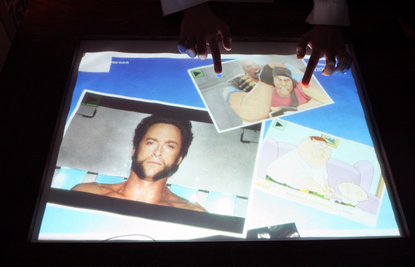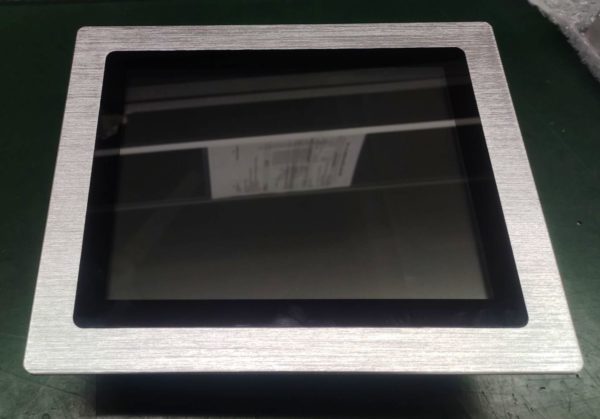

Most importantly, the system is thoroughly evaluated as to its usability, through a pilot application that was developed for this purpose. An accurate technique for touch detection is proposed, while touch detection and projection accuracy issues are studied and evaluated through extensive experimentation. Images on the screen can be moved around with a fingertip and made bigger or smaller by placing two fingertips on the images edges and then either spreading. Corning Willow Glass What is surface computing Developments done till now. The geometry for mapping visual content and localizing fingertip contacts upon this steerable display is provided, along with pertinent calibration methods for the proposed system. Modulation of surface posture supports the ergonomy of the device but can be, alternatively, used as a means of user-interface input. Two-handed, multi-touch surface computing provides a scope for interactions that are closer analogues to physical interactions than classical windowed. The surface is mounted on two gimbals which, in turn, provide two rotational degrees of freedom. Interactivity is provided through sensitivity to the contact of multiple fingertips and is achieved through the use of a RGBD camera. 185–192.In this paper, a steerable, interactive projection display that has the shape of a disk is presented. Wu, M., Shen, C., Ryall, K., Forlines, C., Balakrishnan, R.: Gesture Registration, Relaxation, and Reuse for Multi-Point Direct-Touch Surfaces. Wobbrock, J., Morris, M.R., Wilson, D.A.: User-Defined Gestures for Surface Computing. Wise, J.A., Thomas, J.J., Pennock, K., Lantrip, D., Pottier, M., Schur, A., Crow, V.: Visualizing the non-visual: spatial analysis and interaction with information from text documents. Wilson, A.D., Izadi, S., Hilliges, O., Garcia-Mendoza, A., Kirk, D.: Bringing physics to the surface. Tse, E., Greenberg, S., Shen, C., Forlines, C., Kodama, R.: Exploring true multi-user multimodal interaction over a digital table. Thomas, J.J., Cook, K.A.: Illuminating the Path. Stasko, J., Görg, C., Liu, Z.: Jigsaw: supporting investigative analysis through interactive visualization. Robinson, A.C.: Collaborative Synthesis of Visual Analytic Results. IEEE Computer Graphics and Applications 27(5), 46–56 (2007) Proulx, P., Chien, L., Harper, R., Schroh, D., Kapler, T., Jonker, D., Wright, W.: nSpace and GeoTime: A VAST 2006 Case Study. Pedersen, E.R., McCall, K., Moran, T., Halasz, F.T.: An Electronic Whiteboard for Informal Workgroup Meetings. ACM Transaction on Computer-Human Interaction 5(4), 326–359 (1998)
#MULTITOUCH SURFACE COMPUTER MANUAL#
Leganchuk, A., Zhai, S., Buxton, W.: Manual and Cognitive Benefits of Two-Handed Input: An Experimental Study. Klemmer, S.R., Newman, M.W., Farrell, R., Bilezikjian, M., Landay, J.A.: The Designers’ Outpost: A Tangible Interface for Collaborative Web Site Design. Multi-touch, in a computing context, is an interface technology that enables input through pressure and gestures on multiple points on the surface of a. Jong Jr., A.C., Landay, J.A., Rowe, L.A.: Implications for a Gesture Design Tool. I2 – Analyst’s Notebook, (accessed 29 January 2009) Hinckley, K., Baudisch, P., Ramos, G., Guimbretière, F.: Design and Analysis of Delimiters for Selection-action Pen Gesture Phrases in Scriboli. Van Ham, F., Rogowitz, B.: Perceptual Organization in User-Generated Graph Layouts.

Keywordsįorlines, C., Wigdor, D., Shen, C., Balakrishnan, R.: Direct-Touch vs. We find that users who start with the physical model finish the task faster when they move over to using the surface than users who start with the mouse. To compare users’ gestures we produced a vocabulary of manipulation techniques that users apply in the physical world and we compare this vocabulary to the set of gestures that users attempted on the surface without training.

Inspired by the need for object manipulation in information visualization applications, we asked users to carry out an object sorting task on a physical table, on a tabletop display, and on a desktop computer with a mouse. In this paper we study whether familiarity with other environments influences how users approach interaction with a multi-touch surface computer as well as how efficiently those users complete a simple task. The design of natural and intuitive gestures is a difficult problem as we do not know how users will approach a new multi-touch interface and which gestures they will attempt to use. Two-handed, multi-touch surface computing provides a scope for interactions that are closer analogues to physical interactions than classical windowed interfaces.


 0 kommentar(er)
0 kommentar(er)
